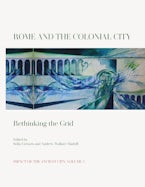According to one narrative that received almost canonical status a century ago with Francis Haverfield, the orthogonal grid was the most important development of ancient town planning, embodying values of civilisation in contrast to barbarism, diffused in particular by hundreds of Roman colonial foundations. Its main legacy to subsequent urban development was the model of the grid city, spread across the New World in new colonial cities.
This book explores the shortcomings of that all too colonialist narrative and offers new perspectives. It explores the ideals articulated both by ancient city founders and their modern successors; looks at new evidence for Roman colonial foundations to reassess their aims; and considers the many ways post-Roman urbanism looked back to the Roman model with a constant re-appropriation of the idea of the Roman.
Series preface
Acknowledgements
List of figures
List of contributors
1. Introduction: Decolonising the Roman grid
Sofia Greaves and Andrew Wallace-Hadrill
Part I. City planning and Ideals of the city
2. Greek colonies and ideals of equality
Irad Malkin
3. Ancient ideals and modern interpretations
Andrew Wallace-Hadrill
4. Urban ideals in the medieval world: spatial order, ruling the realm and the design of towns under Edward I
Keith Lilley
5. The making of men and cities: Francesc Eiximenis and urban development
Sam Ottewill-Soulsby
6. Ancient cities in new worlds: neo-Latin views and Classical ideals in the sixteenth century
Javier Martínez-Jiménez and Sam Ottewill-Soulsby
7. Ideals of the city in the early Islamic foundation stories of Kufa and Baghdad
Edward Zychowicz-Coghill
8. The grid enframed: mapping the enframings of the American Grid
Reuben Rose-Redwood
Part 2. Roman colonization and urban experimentation
9. The practice of urban settlement in Emilia Romagna: between spontaneous development, master-planning and post-antique adaptation
Alessia Morigi
10. The long-term aspects of urban foundation in the cities of Africa Proconsularis
Andrew Dufton
11. Late antique new cities
Efthymios Rizos
12. Foundational grids and urban communities in the Iberian Peninsula in Antiquity and the Middle Ages
Javier Martínez Jiménez
13. Town planning from Falerii to Isurium: understanding and enhancing the archaeological evidence
Martin Millett
Part 3. The impact of the Roman urban model
14. From Potentia to Porto Recanati: the Roman coastal colony and its modern legacy
Frank Vermeulen
15. New towns of the twelfth to fourteenth centuries and the grid plan
Wim Boerefijn
16. Re-imagining the grid in the nineteenth century: to be, or not to be Rome
Sofia Greaves
17. Searching for Rome: French colonial archaeology and urban planning in Morocco
Said Ennahid
18. Planning the colonial capital: Khartoum and New Delhi
Robin Cormack
19. Roma rediviva: the uses of Roman heritage in Fascist-era urbanism
Aristotle Kallis
20. Urban planning and ideology: the Fascist layer on Rome’s city centre and the EUR district
Flaminia Bartolini












